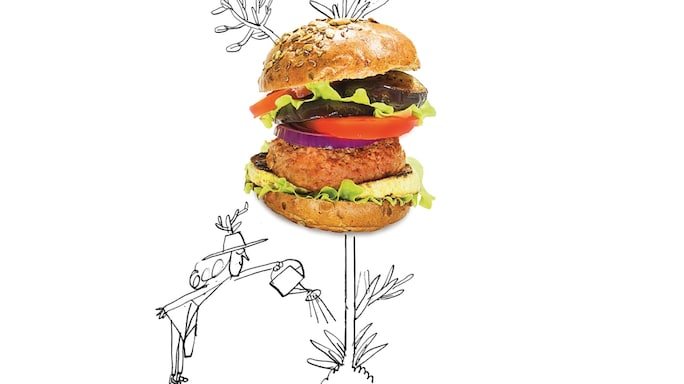- HOME
- /
- Better Living
- /
- Food
- /
What You Should Know about Plant-Based Meat
13 surprising facts about the mock-meat food trend
 illustration by Serge Bloch
illustration by Serge Bloch
1
If you tried veggie burgers years ago and dismissed them as rubbery, flavourless hockey pucks, it’s a good time to give meat substitutes another chance. You can find plant-based versions of chicken, pork, sausage, and deli cuts, as well as seafoods such as tuna and shrimp. Newer varieties mimic the look, flavour and texture of the real thing. Some even “bleed” like meat and give off that signature sizzle as they cook.
2
According to a 2021 Pew Research Center survey, 61 per cent of Indian adults are meat-eaters. But about 41 per cent of Indians restrict their meat consumption in some way, paving a way for easy conversion to plant-based meat. Though the Indian mock meat market is at a nascent stage, it has been predicted to grow from $30–$40 million in 2021 to $500 million in the next three years, according to a survey conducted by retail broking company Nirmal Bang. This explains the recent mushrooming of several Indian alternative meat brands in the space.
3
Clearly Plant-based proteins aren’t just for vegetarians and vegans. Impossible Foods and Beyond Meat—two of the biggest names in the industry—report that more than nine out of 10 of their consumers also eat meat.
4
Buyer beware: Mock meats can be high in sodium and can have as much saturated fat and as many calories as real meats. As for protein, the amount in veggie burgers ranges from about 4 to 20 grams (85 grams of chickencontains 26 grams), but the better protein options tend to have more saturated fat.
5
Many meatless manufacturers don’t disclose their total emissions, but research shows they generate a lot less greenhouse gas compared to their meat equivalents. One study found that making the Beyond Burger uses 99 per cent less water, 93 per cent less land, and nearly 50 per cent less energy than making a quarter pound beef burger does.
6
Whether or not these products can be called ‘meat’ depends on where they’re sold. A growing number of US states have banned plant-based companies from using the word on their product labels—even with a qualifier such as ‘vegetarian’. Lawmakers say they don’t want consumers to be tricked into buying fake meat by mistake. Some food manufacturers have challenged the law in court, saying it limits free speech and is intended to protect the meat industry.
7
The biggest FMCG brands in India such as ITC and TATA consumer products now sell their own entirely plant-based meat options. It’s a smart sideline: Sales soared to $7 billion in 2020, and Bloomberg predicts the market will skyrocket to $74 billion by 2030—a 957 per cent surge.
8
Even fast food is jumping on the bandwagon. Burger King has the Impossible Whopper. McDonald’s is testing a Beyond burger called the McPlant. And KFC is working on fake fried chicken as finger-lickin’ good as the original.
9
You can make your own meatless chicken with only two ingredients, as millions of TikTok users learned in a viral video last year. Just mix together flour and water, then knead it and rinse it under more water to wash out the starch. You’ll get a dough that looks (and sort of tastes) like chicken. The trick is a version of a meat alternative called seitan (pronuonced 'say-tan), or wheat gluten, which has been around for centuries.
10
According to a report published by the US Department of Agriculture, India is a “burgeoning market” for mock meat. And this trend, unlike popular perception isn’t restricted to the Indian metros. The Nirmal Bang report found that tier-2 cities drive consumption of smart protein, where consumers are not only trying these products but are making repeat purchases.
11
Impossible Foods spent years developing a molecule called heme (rhymes with seem), which gives its products a bloody red appearance and beefy taste. (For many who find meat unpalatable, heme will be similarly unappetizing.) The nonprofit Center for Food Safety filed a lawsuit challenging FDA approval of heme, but an appeals court later upheld the decision to declare it safe to eat.
12
The new frontier of meat alternatives is lab-grown, also called cultured or cell-based meat. Grown in test tubes from the stem cells of animals, they are still animal products, but they don’t require breeding, raising or slaughtering. A plant-based option is mushroom meat, which mimics the texture of whole cuts such as steaks, and slices and serves like them too.
13
New alternate meats get all the attention, but Indians, historically have been consuming soybeans, jackfruit, dairy, and pulses for protein. Beans and lentils are excellent protein substitutes, says Kari Hamerschlag, deputy director of food and agriculture at Friends of the Earth, a nonprofit environmental organization. “They’re nutritious, inexpensive, and far more sustainable than any of the processed meatless substitutes on the market today.”






